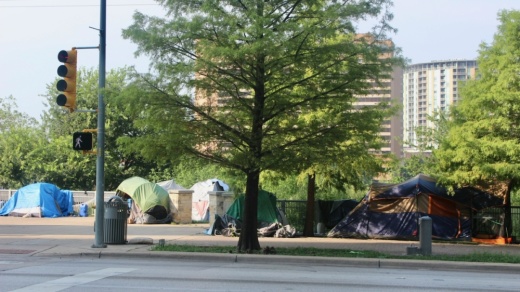The plan was produced from the weekslong Summit to Address Unsheltered Homelessness in Austin, which featured participation from local government, business and nonprofit representatives to form a collaborative approach to permanently reduce homelessness on Austin's streets. The city of Austin announced its intentions to dedicate tens of millions of pandemic relief dollars to the effort this spring, and Travis County announced an allocation of similar size for homelessness housing and strategy this week.
The Summit Plan's top goal involves housing 3,000 people experiencing homelessness by April 2024 on top of the existing capacity of the Austin-area housing system and also aims to add hundreds of new supportive housing units in the area.
To reach those targets, the plan was crafted with a series of benchmarks designed to gradually ramp up over the coming years. The first objective of 100 new housings from April through June was not achieved with the summit reporting a total of 79 moves into stable housing as of June 30.
Housing figures used to track plan targets come from the Homeless Management Information System managed by the nonprofit Ending Community Homelessness Coalition. The second incremental goal called for 200 total housings through August, although results for that time period are not yet available given a reporting delay from homeless service providers logging their data, according to ECHO.
The plan is being funded by a combination of sources. The three-year plan was projected to cost $515 million, around $222 million of which was identified as "committed or anticipated" to the project when the summit closed in April. Those expected dollars—just over 43% of the plan's estimated requirement—could come from a combination of grants, loans, bonds, and state and federal support, leaving a need for $293 million more from other sources.
The city of Austin made a sizable push to reduce that gap in June with the potential dedication of up to $106.7 million in federal American Rescue Plan Act dollars for homeless programs. Of that pot, $88.6 million was specifically earmarked for the Summit Plan with focus points including housing services and rental support, case management and mental health services, homeless system capacity increases and expenses related to supportive housing.
Money was also allocated for the future of Austin's Homeless Encampment Assistance Link program. The first phase of that initiative moved more than 140 people at four unregulated camps into city shelters this summer, and City Council has approved spending $6 million on a second round of the program targeting new encampments beginning this fall.
Austin leaders pitched the ARPA investment in city homelessness strategy as a historic one after their approval of a spending framework in June, but none of the money has been used so far—and it could be held up, depending on the actions of other Summit Plan participants.
Austin City Council voted for the homelessness spending "contingent on external partners committing or securing funding of at least $200 million" to completely bridge the estimated funding gap. A city spokesperson said $4 million of the $106.7 million has been allocated so far for operations at Austin's Northbridge shelter, none of which has been spent, and how the remainder of that fund will be distributed is not yet certain.
Council also approved the ARPA framework with direction that city staff should develop a detailed blueprint for spending on the Summit Plan by July 1. However, that overview has yet to be produced and is not expected to be released until next month.
"[Homeless Strategy Officer] Dianna Grey is working with city and response partners and plans to share an update on the financial model with Council in October," the city spokesperson said.
An additional ask that summit partners provide the city with both individual fundraising plans and an overview of the partnership's leadership and decision-making structures by July 15 also has yet to be fulfilled.
Another component of the ARPA spending framework set in June involves community participation in a homelessness spending plan. Council directed that at least two public forums and a virtual feedback opportunity via the SpeakUp! Austin website come prior to Sept. 1 or before $10 million of the allocation is spent. The city is now "working toward" launching the webpage, and an announcement regarding the public meetings is coming in late September, the spokesperson said.
Regional partnership
Months after Austin's first actions related to its Summit Plan contributions, Travis County laid out how it plans to join the regional homelessness strategy. County commissioners unanimously voted to send $110 million of the county's ARPA funding to combat homelessness and build out local affordable housing Sept. 14.
In approving the federal funding earmark, Travis County officials referenced the requirements of the Summit Plan and said the money will go toward adding 2,000 supportive housing units in partnership with local developers and homeless service providers.
Collaboration among Austin and Travis, Williamson and Hays counties on a homelessness strategy was established as a city policy back in June, when a resolution sponsored by District 6 Council Member Mackenzie Kelly directing interagency coordination on the topic was unanimously passed by city officials. How that work ties into the Summit Plan is also uncertain. While Grey said her office has engaged Travis County officials on homeless strategy, talks with Williamson County have stalled in the wake of Austin's contentious Candlewood Suites purchase for homeless housing last month and a related lawsuit planned by the county.
Connie Odom, Williamson County's public affairs manager, said the county had no update on the status of the lawsuit as of Sept. 17. She also said county officials were not invited to the summit and have not looked to approve funding for the plan.
Austin homelessness strategy staff did meet with service providers in the Williamson County Homeless Coalition, however, Grey said in a memo, and will also work to set up regular meetings on the topic with representatives of all three counties going forward.





